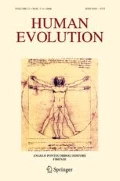Abstract
Cercopithecids did not arrive in China until the latest Tertiary, relatively late in their evolutionary history.
Cercopithecines are represented in the Chinese fossil record by two genera,Procynocephalus andMacaca, both of which made their appearance in the Late Pliocene or Early Pleistocene, but only one of which,Macaca, was widely distributed throughout the Quaternary and remains in the country today. The much less well known genusProcynocephalus disappeared from China in the late Early Pleistocene, but is of considerable interest because it appears to have been part of a radiation of large terrestrial cercopithecines that extended throughout portions of southern and eastern Asia.
Colobines are poorly represented in the fossil record of China. Aside from a few scattered occurrences ofRhinopithecus in the Middle and Late Pleistocene records of southern China, the subfamily is represented by only one other intriguing specimen. This is the large and nearly complete mandible now classified as «Megamacaca lantianensis» from the Gongwangling locality of Lantian, Shaanxi Province. The specimen was retrieved from sediments of late Early Pleistocene age and was associated with elements of a typical southern,Ailuropoda — Stegodon fauna. The distribution of cercopithecids, especiallyMacaca, in China followed the southern and eastern retreat of subtropical habitats during the course of the Pleistocene.
Similar content being viewed by others
References
Colbert E.H. &Hooijer D.A., 1953.Pleistocene mammals from the limestone fissures of Szechuan, China. Bulletin of the American Museum of Natural History 102: 1–124.
Delson E., 1977.Vertebrate paleontology, especially of nonhuman primates, in China In (W.W. Howells and P.J. Tsuchitani, Eds.), Paleoanthropology in the People's Republic of China, pp. 40–65. National Academy of Science, Washington.
Delson E., 1980.Fossil macaques, phyletic relationships and a scenario of deployment. In (D.G. Lindburg, Ed.) The Macaques: Studies in Ecology, Behavior and Evolution, pp. 10–30. Van Nostrand, New York.
Groves C.P., 1967.The forgotten leaf-eaters, and the phylogeny of the Colobinae. In (J.R. Napier and P.H. Napier, Eds.) Old World Monkeys, pp. 555–587. Academic Press, New York.
Gu Y.-M., 1980.A Pliocene macaque's tooth from Hubei. Vertebrata Palasiatica, 18: 324–326.
Guo S.-L., Zhou, S.-H., Meng, W., Zhang, P.-F., Sun, S.-F., Hao X.-H., Liu S.-S., Zhang F., Hu R.-Y. &Liu J.-F. 1980.Age determination of Peking Man by fission track dating. Kexue Tongbao, 25: 535–536.
Heller F. &Liu T.-S., 1982.Magnetostragraphical dating of loess deposits in China. Nature, 300: 431–433.
Hu C.-K. &Qi T., 1978.Gongwangling Pleistocene mammalian fauna of Lantian, Shaanxi. Palaentological Sinica, Whole number 155, New Series C, Number 21, PP. 1–64.
Jolly C.J. 1967.The evolution of baboons. In (H. Vagtborg Ed.) The Baboon in Medical Research, Volume II, pp. 23–50, University of Texas Press, Austin.
Liu D.S. (T.-S.) &Ding M.-L. 1984a.The characteristics and evolution of the palaeoenvironment of China since the late tertiary. In (R.O. Whyte, Ed.) The Evolution of the East Asian Environment, Volume I, pp. 11–40. Centre of Asian Studies, Hong Kong.
Liu D.S. (T.-S.) &Ding M.-L., 1984b.A tentatitive chronological correlation of early human fossil horizons in China with the loess-deep sea records. Acta Anthropologica Sinica, 3: 93–101.
Pope G.G., 1984.The antiquity and paleoenvironment of the Asian Hominidae. In (R.O. Whyte, Ed.) The Evolution of the East Asian Environment, Volume II, pp. 822–847. Centre of Asian Studies, Hong Kong.
Qian F., Zhang J.-X. &Yin W.-D., 1980.Magnetostratigraphic study on the cave deposits containing fossil Peking Man at Zhoukoudian. Kexue Tongbao, 25: 359.
Schlosser M., 1924.Fossil primates from China. Paleontologica Sinica, Series C, 1: 1–16.
Shackleton N.J. &Opdyke N.D., 1973.Oxygen isotope and palaeomagnetic stratigraphy of equatorial Pacific core V28-238: oxygen isotope temperatures and ice volumes on a 10 5 year and 10 6 year scale. Quaternary Research, 3: 39–55.
Simons E.L., 1970.The deployment and bistory of Old World Monkeys (Cercopithecidae, Primates). In (J.R. Napier and P.H. Napier, Eds.) Old World Monkeys pp. 97–137. Academic Press, London.
Teilhard de Chardin P., 1938.The fossils from locality 12 of Choukoutien. Paleontologica Sinica, New Series C, 51: 1–46.
Wang P., 1984.Progress in Late Cenozoic palaeoclimatology of China: a brief review. in 7R.O. Whyte, Ed.) The Evolution of the East Asian Environment, Volume I, pp. 165–187. Centre of Asian Studies, Hong Kong.
Whyte R.O. Ed., 1984.The evolution of the East Asian Environment. Two volumes, Centre of Asian Studies, Hong Kong.
Xu Q.-Q. &You Y.-Z., 1982.Four post-Nibewanian Pleistocene mammalian faunas of North China: correlation with deep-sea sediments. Acta Anthropologica Sinica, 1: 180–190.
Xu R. 1984a.Changes of the palaeoenvironment of southern East Asia since the Late Tertiary In (R.O. Whyte, Ed.) The Evolution of the East Asian Environment Volume II, pp. 419–425. Centre of Asian Studies, Hong Kong.
Xu R., 1984b.Changes of the vegetation in China since the Late Tertiary. In (R.O. Whyte, Ed.) The Evolution of the East Asian Environment, Volume I, pp. 426–432. Centre of Asian Studies, Hong Kong.
Zhang Y.-Z., Wang S. &Quan G.-Q., 1981.On the geographical distribution of primates in China. Journal of Human Evolution, 10: 215–226.
Author information
Authors and Affiliations
Rights and permissions
About this article
Cite this article
Pan, Y.R., Jablonski, N.G. The age and geographical distribution of fossil cercopithecids in China. Hum. Evol. 2, 59–69 (1987). https://doi.org/10.1007/BF02436531
Received:
Accepted:
Issue Date:
DOI: https://doi.org/10.1007/BF02436531




